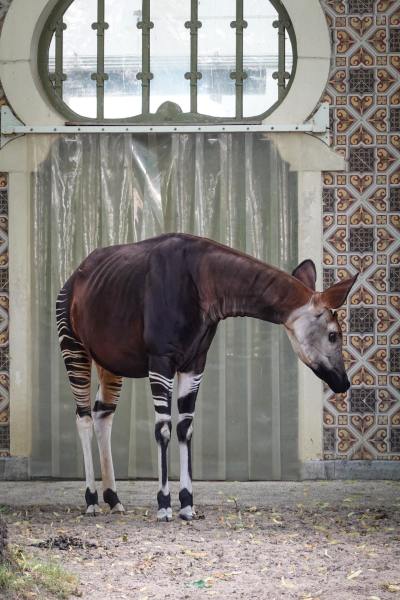
In 1871, Welsh-American adventurer Henry Morton Stanley succeeded in his well-publicised search for ‘missing’ Scottish missionary/explorer David Livingstone.
After their famous encounter in what is now Tanzania, Stanley accepted a commission from the notorious King Leopold II of Belgium to explore the Congo region. During his explorations Stanley heard of a strange and large forest animal the local pygmy tribespeople called atti, or o’api
Although he had never seen one himself, Stanley mentioned the creature in his 1890 book In Darkest Africa. From the Mbuti tribes’ descriptions, he thought it was a donkey.
In 1900, a German entrepreneur kidnapped some Mbuti pygmy tribespeople from their Ituri Forest village in the Congo. His plan was to display them as live exhibits at the Paris Exhibition. Although Belgian soldiers stationed in the Congo gave chase, the showman managed to flee into Uganda. The Belgian government requested Sir Harry Johnston (British colonial administrator and keen amateur naturalist) to intervene. He duly freed the abductees “and sent the evildoer back to Germany”.
While in Uganda, the grateful rescued Mbuti answered the curious governor’s questions about the o’api (soon anglicized as okapi).
Johnston resolved to accompany the rescued Mbuti back into the Belgian Congo, in hopes of seeing an okapi himself.
Shy and quiet
The okapi are notoriously shy and quiet, their large ears can detect the slightest sound and it was not until 2008 a photograph of an okapi in the wild was obtained from a camera trap.
Doubted knowledgeable advice
As Johnston and his expedition party were tramping wearily through the Tanzanian jungle in July 1900, the Mbuti guides suddenly became excited, pointing out okapi tracks in the wet earth. However, these were of a cloven-hoofed animal, whereas from Stanley’s account Johnston was expecting a donkey and so refused to follow them (supporters of evolutionary theory make a similar error. They doubt the most reliable eyewitness testimony [the Bible] and are very selective about what physical evidence they will follow.)
Johnston and his group were soon badly affected by illness and the oppressive jungle humidity so they turned back to Fort Mbeni, an outpost on the fringe of the Ituri Forest.
The Belgian commander there, Lieutenant Meura, had seen okapi carcasses and skins and gave Johnston a pair of okapi-skin bandoliers. The bandoliers had been made from the portion of skin on the rear legs of the okapi which are striped like a zebras.
An apparently new species of zebra
Arriving back in Uganda, Governor Johnston sent the two bandoliers to the London Zoological Society for identification. English zoologist Philip Sclater examined the two pieces of skin and found the hairs to be structurally indistinguishable from a zebra.
At the 5th February 1901 meeting of the London Zoological Society, Sclater declared the skin pieces were from “an apparently new species of zebra”
Meanwhile, back in the Congo, Lieutenant Meura died of blackwater fever.
Meura’s 2IC, Karl Erikson, was able to send Johnston a complete okapi skin, two skulls, and some hooves. When reading this letter and seeing the complete skin and the two skulls, Johnston finally realised the okapi could not be a donkey or zebra.
Like an extinct giraffe
Johnston recognized the giraffe-like characteristics of the knob-like hair-covered horns (ossicones) on one of the skulls. From the skin Johnston could see the neck wasn’t long and so concluded the okapi was from the giraffe family (Giraffidae) and was most like the extinct Miocene fossil genus Helladotherium. He sent the skulls and skin on to England, suggesting the name Helladotherium tigrinum which led to it being called the ‘forest giraffe’.
Evolutionary ideas - wrong conclusion
Dubbed a ‘living fossil,’ the okapi was hailed as being “one of the survivors of the giraffine group, … flourishing in southern Asia and Europe during Miocene ages, several million years ago. The okapi had found a safe retreat in the heart of Africa, in the gloom of the Congo forests.” (About 30,000 okapis are found in the wild today. They live only in the tree-covered mountainous areas of the Democratic Republic of the Congo, formerly Zaire).
Modern evolutionists are saying the okapi and the giraffe shared a common ancestor. On the basis of mitochondrial DNA comparisons, evolutionists concluded the okapi and the giraffe split from that common ancestor 16 million years ago. A subsequent DNA study came up with an estimate “substantially less,” i.e., 11.5 million years ago.
Creationists would agree giraffes and okapis had a common ancestor (being of the same created ‘kind’) but would put the timeline at only about 4,500 years ago, thanks to the Bible’s reliable historical account of Noah’s Ark and the Genesis Flood.
Evolutionary ideas adversely affect not only academic pursuits, but people and society. The German showman’s intent to display the Mbuti as live exhibits in Paris would have almost certainly been in line with Darwinian notions of, and Europeans’ curiosity about, the ‘lesser evolved races’ of the world.
Both creationists and evolutionists pretty much agree today the chance of finding a living dinosaur is remote. The primary reason evolutionists give - dinosaurs have been extinct for about 65 million years - is seriously flawed. The coelacanth fish and the Wollemi pine for example, were both previously known only from ‘dinosaur-age’ fossils.
Evolutionists have still not been able to provide a satisfactory explanation of how these can be living today and yet be completely absent as fossils in rocks ‘dated’ as being younger than 60 million years.
Note:This article is paraphrased from an article in Creation Magazine, Vol 44, August 2022 by David Catchpoole, B.Ag.Sc.(Hons), Ph.D

John Skinner served as an infantry soldier in Vietnam then the Tasmanian Police before taking up the position of CEO of the Australian Rough Riders Association (professional rodeo based in Warwick Qld). Before retirement to his small farm, he was a photo-journalist for 25 years. He is married with 3 children and 7 grandchildren.